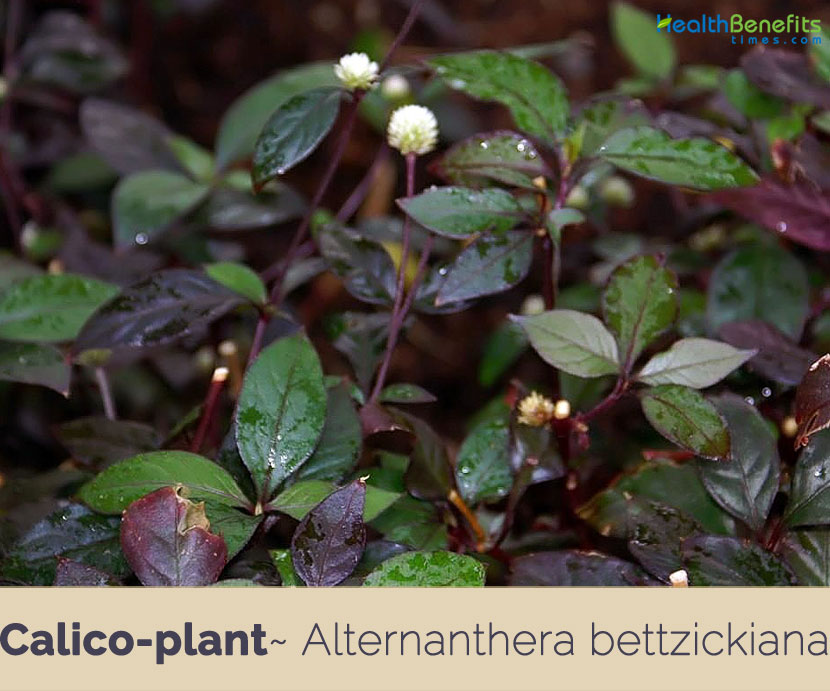| Calico-plant Quick Facts | |
|---|---|
| Name: | Calico-plant |
| Scientific Name: | Alternanthera bettzickiana |
| Origin | South America |
| Shapes | Fruits are slightly more than 1 mm long, enclosed in the persistent perianth segments and bracts. |
| Health benefits | Treat arthritis, gastrointestinal distress, emmenagogue, menstrual cramps, promote lactation, improve blood circulation and prevent dementia |
Plant Description
Calico plant is an herbaceous perennial plant that grows between 20 and 50 cm tall. The plant is found growing in open areas of degraded deciduous forest, wastelands and river margins. Normally the plant prefers an organically rich, consistently moist and well-drained soil. Stem is erect or creeping, much-branched, with the apical part of the stem quadrangular, and the basal part cylindrical. Few hairs are present at the nodes and the apex, as well as at the level of the short petioles
Leaves
Leaf blades are about 4-9 cm long and 1.5-4 cm wide, petioles are up to 1-2 cm long but sometimes very short or absent. Both the upper and lower surfaces of the leaf blade are pilose and pustular. Twigs are longitudinally ribbed, densely clothed in multi celled, minutely barbed, white hairs.
Flowers
Flowers are present in axillary sessile spikes or clusters. Perianth segments are about 3-5 mm long, clothed in pale hairs. Staminal filaments are fused towards the base, anthers about 1-2 mm long, free filaments about 1.5-2 mm long, staminodes alternating with the stamens. Staminodes are about 2.5-3 mm long, apices toothed or lobed. Ovary is about 1 mm long, enclosed in the staminal tube. Style is short, about 0.5 mm long.
Infructescence is very much like the inflorescence, i.e. consisting of tightly packed bracts interspersed with pale hairs. Individual fruits are slightly more than 1 mm long, enclosed in the persistent perianth segments and bracts. Seeds are discoid, about 1 mm diam., testa brown.
Traditional uses and benefits of Calico Plant
- Alternanthera bettzickiana is used to treat anemia in children.
- It is also used to treat arthritis, gastrointestinal distress, and emmenogogue, menstrual cramps, to promote lactation, to improve blood circulation and prevent dementia.
- It is also ground and used to treat snake bites.
- The cooked vegetable is given to anemic children in order to improve their health.
Culinary Uses
- The leaves and young shoots are edible, eaten in salads or as a vegetable.
- Leaves and young shoots can be consumed raw or cooked.
- Mild flavored, they can be eaten in salads or boiled and used as a vegetable.
Other facts
- bettzickiana is used for erosion control and soil improvement due to its extensive root system.
- It is used in tea plantations, croplands and orchards to hold soil.
- It is also used as a fodder for goats and rabbits.
- In Central America is used as an ant repellent.
References:
https://www.itis.gov/servlet/SingleRpt/SingleRpt?search_topic=TSN&search_value=822922#null
https://npgsweb.ars-grin.gov/gringlobal/taxonomydetail.aspx?id=105429
https://www.cabi.org/isc/datasheet/120104
https://en.wikipedia.org/wiki/Alternanthera_bettzickiana
http://en.hortipedia.com/wiki/Alternanthera_bettzickiana#
http://www.theplantlist.org/tpl1.1/record/kew-2631089
http://tropical.theferns.info/viewtropical.php?id=Alternanthera+bettzickiana
https://indiabiodiversity.org/species/show/225405
https://www.flowersofindia.net/catalog/slides/Calico%20Plant.html
https://wikivisually.com/wiki/Alternanthera_bettzickiana
http://www.efloraofgandhinagar.in/herb/alternanthera-bettzickiana
https://gd.eppo.int/taxon/ALRBE
http://www.stuartxchange.org/Kutcharitas
https://davesgarden.com/guides/pf/go/56928/#b
Comments
comments
